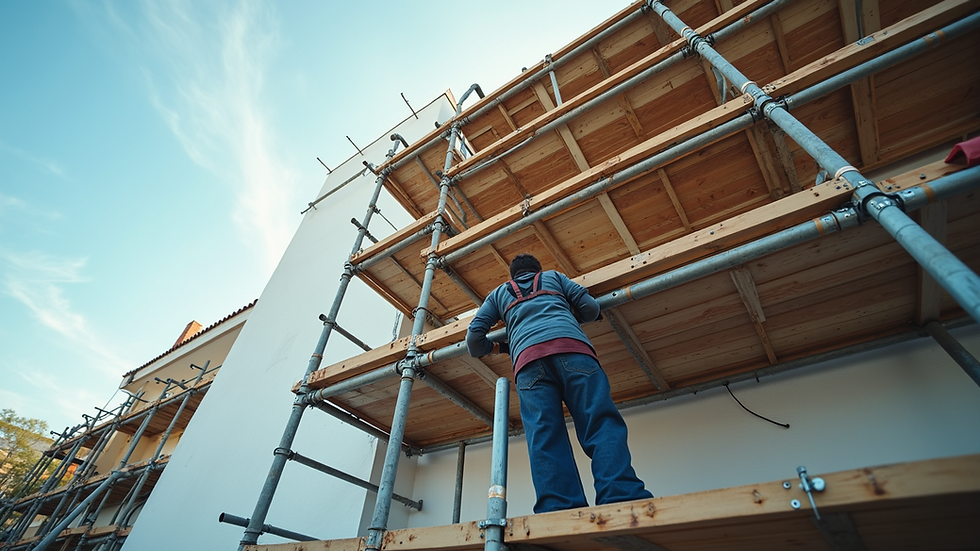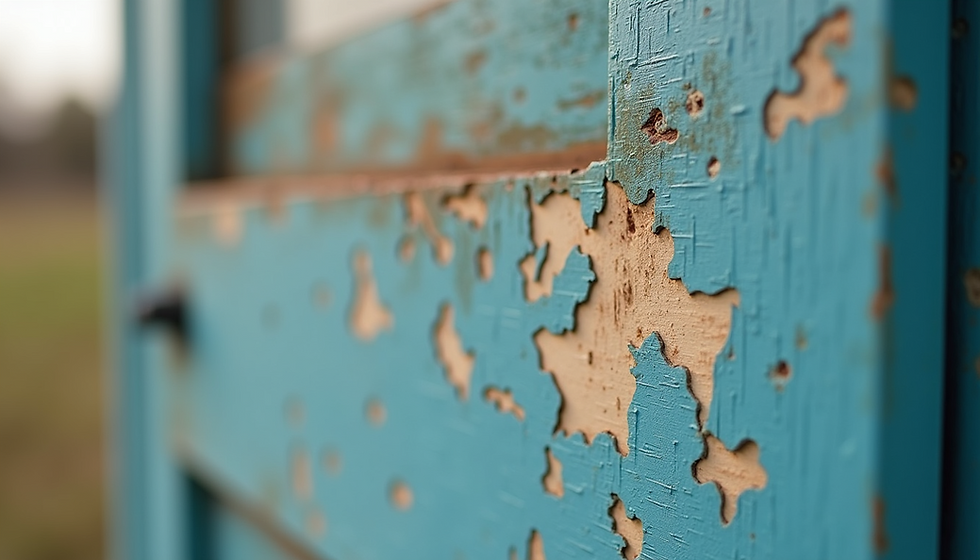Exterior Painting Safety: Working with Ladders and Scaffolding
- Angel Sosa
- Sep 1
- 5 min read
Painting your home’s exterior can be a rewarding project, but safety must be your top priority. Working at heights, whether on ladders or scaffolding, poses significant risks. According to the Occupational Safety and Health Administration (OSHA), falls are the leading cause of fatalities in construction. This highlights the need to follow safety protocols to prevent serious accidents. In this post, we'll share crucial precautions for handling tall exteriors while painting and discuss how hiring professionals can save you time, reduce risk, and ultimately, save money.
Importance of Safety When Painting Exteriors
Exterior painting often requires you to reach second-story siding or eaves. Unfortunately, falls from heights are common. The National Safety Council reports that over 50,000 ladder-related injuries occur annually in the United States, necessitating awareness of how to work safely with ladders and scaffolding.
Improper use of these tools can result in serious injuries. These not only affect your health but can also lead to overwhelming medical expenses and lengthy recovery times. By prioritizing safety, you can prevent these risks and potentially save thousands in medical bills.
Choosing the Right Equipment
Choosing the suitable ladder or scaffolding system is essential for your safety. Here’s a breakdown of the most common types of equipment you might consider for exterior painting.
Types of Ladders
A-Frame Ladders: Ideal for low to medium heights, these ladders offer great stability. Always ensure that your A-frame is fully opened and locked before climbing. For example, if you are painting under eaves at around 10 feet, an A-frame ladder can provide the stability you need.
Extension Ladders: These ladders give you the reach needed for higher areas. When using an extension ladder, remember the "4:1 rule" – for every four feet of height, the base should stand one foot away from the wall. This adjustment can make a difference between safety and a fall.
Multi-Use Ladders: These flexible systems can convert into either A-frame or extension ladders, allowing for use in various situations. Always consult the guidelines to make sure you are using them correctly

Sturdy ladder positioned correctly for exterior painting.
Types of Scaffolding
Basic Scaffolding: Comprising a simple platform supported by poles, basic scaffolding is excellent for larger painting areas. Ensure it is set up on level ground, and double-check stability.
Suspended Scaffolding: Used for taller buildings, this scaffolding is hung from the roof. It's vital to ensure proper installation to maintain your safety.
Rolling Scaffolding: These mobile units let you move easily during your project. Just remember to lock the wheels in place before you step onto the scaffold!
Selecting the appropriate ladder or scaffolding based on your project needs is essential for both safety and efficiency.
Safety Precautions When Using Ladders
1. Inspect Your Ladder
Before each use, check your ladder thoroughly for damage. Look for cracks, loose rungs, or any signs of wear. If you see a problem, opt for a new ladder. Ladder injuries account for about 81% of falls from vertical heights.
2. Set Up Properly
Always position your ladder on a flat, stable surface. For uneven ground, consider using ladder levelers. Make sure to follow the 4:1 rule for safer extension ladder placement.
3. Maintain Three Points of Contact
When climbing, keep either two hands and one foot or two feet and one hand in contact with the ladder at all times. This practice greatly reduces your chance of falling.
4. Avoid Overreaching
Keep your body aligned with the ladder. Avoid leaning too far or reaching too much. If you find yourself stretching to reach a painted area, it’s best to move the ladder closer.
5. Stay Aware of Weather Conditions
Check the weather before starting your work. Windy or rainy days make ladders slippery and can lead to accidents. If conditions are not safe, it's best to postpone your painting project.
Safety Precautions When Using Scaffolding
1. Assembly and Disassembly
Always follow the manufacturer’s instructions during assembly and disassembly. Having a partner can also make these processes safer and simpler.
2. Ensure Proper Weight Distribution
Distribute your materials evenly on the scaffold. Overloading can lead to collapses, which are dangerous.
3. Use Guardrails
If you will be working on scaffolding elevated more than 10 feet, installing guardrails is critical for fall prevention. Ensure they are secured before use.
4. Secure the Scaffold
Use outriggers or base plates for added stability. Make sure everything is level, and lock the wheels on any rolling scaffolding.
5. Avoid Electrical Hazards
Be cautious of your environment, especially near power lines. Ensure your scaffolding is at a safe distance to prevent electrical accidents.

The Benefits of Hiring Professionals
While doing your painting can be fulfilling, it also brings certain risks. Hiring professionals can significantly lower these risks. Here are some compelling reasons to consider professional painting services:
1. Expertise
Trained painters know how to handle ladders and scaffolding safely. Their extensive experience allows them to manage various projects effectively while prioritizing safety.
2. Equipment
Professionals have access to specialized tools and safety gear that might be costly for homeowners. This ensures a more secure and efficient painting experience.
3. Insurance
Reputable painting companies carry liability insurance. This means you are protected from the financial burden associated with any accidents that might occur on your property.
4. Time-Saving
Professionals can often finish a painting project much more quickly than the average DIY enthusiast, allowing you to dedicate time to your daily tasks.
5. Quality Finish
With their training, professionals typically deliver a superior finish compared to an untrained effort. This can lead to a more beautiful home exterior and enhance your curb appeal.
Practical Tips for DIY Enthusiasts
If you decide to take on your home’s exterior painting project alone, consider these tips to boost safety and efficiency.
1. Wear Protective Gear
Use safety equipment, including helmets, gloves, and sturdy shoes. If you are on ladders or scaffolding, a harness can add an extra layer of protection.
2. Create a Safety Plan
Draft a safety plan that includes emergency contact numbers and the location of first aid kits on-site.
3. Set Up a Buddy System
Working with a partner can greatly improve safety. A second person can assist you while you’re on ladders or scaffolding, helping to catch potential issues before they become serious.
4. Take Your Time
Rushing can lead to mistakes and accidents. Ensure your setup is correct, and always adhere to safety protocols.
Safety Matters in Painting Projects
Whether you are repainting your home’s exterior or doing a simple touch-up, prioritizing safety with ladders and scaffolding cannot be overstated. Keep the precautions discussed here in mind to reduce the risks associated with working at heights. Additionally, remember the multitude of benefits that come with hiring professionals.
Being a prepared homeowner translates to a safe homeowner. Invest time in safety practices as diligently as you would in executing that perfect paint job. After all, the beauty of your home begins with a secure and safe working environment.

By applying the right practices, you not only protect yourself but also contribute to the long-lasting beauty of your home’s exterior. Happy painting!




Comments